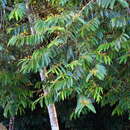Habitat
(
Anglèis
)
fornì da EOL authors
Ranges throghout the Amazonian basin, the Antilles and Central America. Specially common in swampy, fertile soils, along the river banks or in periodically flooded habitats.
Size
(
Anglèis
)
fornì da EOL authors
Tree up to 25 m. high, the trunk up to 80 cm. in diameter, the branches spreading, conspicuously whorled; branchlets often flexuose, tomentellous (hairs branched from base, up to 1 mm. long) or puberulent, at length glabreseent; petioles deeply canaliculate, tomentellous or glabrous, 1.5-2 mm. in diameter, 2-9 mm. long; leaf blades coriaceous, narrowly oblong, parallel-margined, 10-22 cm. long (sometimes shorter on flowering branchlets), 2-5 cm. broad (sometimes up to 35 by 6 cm.), subcordate, rounded, obtuse or acute at base, cuspidate, acute or short acuminate at apex, pale puberulent beneath (hairs sessile- stellate, 5-8-branched, 0.1-0.25 mm. in diameter), the costa plane or shallowly grooved above, prominent beneath, the secondary nerves 16- 30 per side, plane or slightly impressed above, sharply raised beneath, the veinlets obscure or slightly impressed on both surfaces; staminate inflorescences broadly paniculate, many-flowered, freely branching, 7-17 cm. long and nearly as broad, the peduncle often slightly flattened, up to 4.5 cm. long, with the branchlets and flowers golden- or cinereous- puberulent (hairs sessile-stellate, few-branched, about 0.2 mm. in diameter), the ultimate peduncles distally swollen; bracts oblong, puberulent, 3-8 mm. long, conspicuous in young inflorescences, at length deciduous; flowers arranged in ultimate clusters of 5-20, the pedicels slender, up to 4 mm. long; perianth thin carnose or submembranous, 1.6-2.4 mm. long, 3-lobed nearly to base, the lobes oblong, obtuse, often sparsely pellucid-punctate and sometimes with distinct veins; androecium 1.3-1.9 mm. long, the filament column slender, 0.8- 1.3 mm. long, the anthers 3, 0.5-0.8 mm. long, connate to apex, obtuse; pistillate inflorescences 2-8 cm. long at anthesis, the flowers 3-6 per cluster, the pedicels up to 2 mm. long, the bracts as in the staminate inflorescences; ovary subglobose, closely and densely puberulent, the style stout, less than 0.5 mm. long, the stigma flaring, deeply cleft; fruiting infloreseences essentially glabrous throughout, 6-11 cm. long, the mature fruits 3-8 per infloreseence, pedicellate (pedicels stout, 3-7 mm. long), coriaceous, ellipsoid or subglobose, 13-21 mm. long, 11-18 mm. broad, often apiculate at apex, minutely stipitate at base, slightly or distinctly carinate, the pericarp 1-2 mm. thick, the aril cleft nearly to base, the seed slightly ellipsoid.
Distribution
(
Anglèis
)
fornì da EOL authors
Bolivia (Pando); Brazil (Amapá, Amazonas, Ceará, Goiás, Maranhao, Minas Gerais, Pará, Rio de Janeiro); Colombia; Costa Rica; Ecuador; French Guiana; Grenada; Guadeloupe; Guyana; Martinique; Panama; Peru; Suriname; Trinidad and Tobago; Venezuela (Amazonas); Vincents
Benefits
(
Anglèis
)
fornì da EOL authors
One of the most useful species in the Amazon. The fat extracted from the seeds is used to make a variety of soaps and candles. The timber is used for rolling and construction, along with quality paper. Medicinally, it is used locally in the treatment of schistosomiasis and other fever illnesses.

